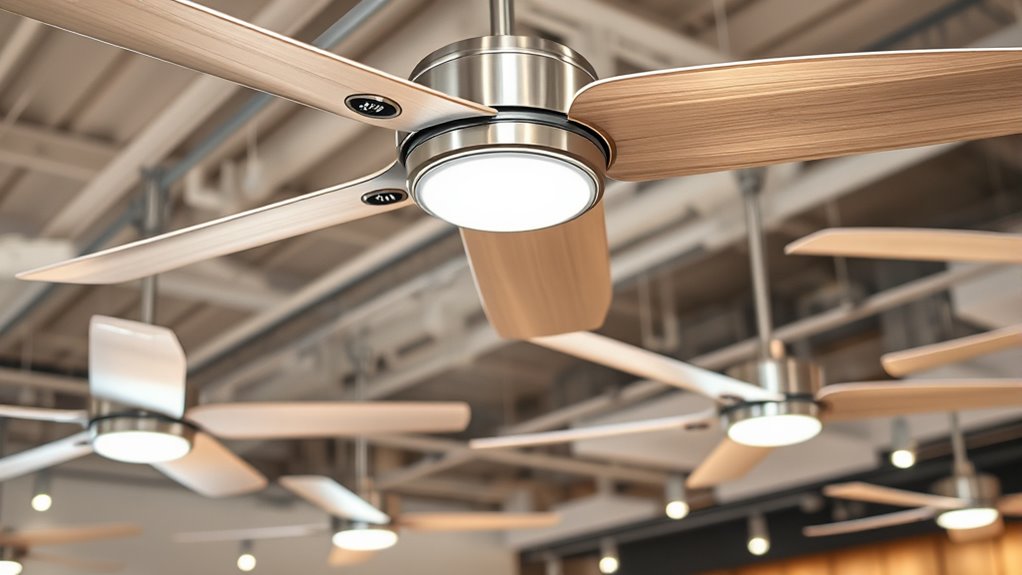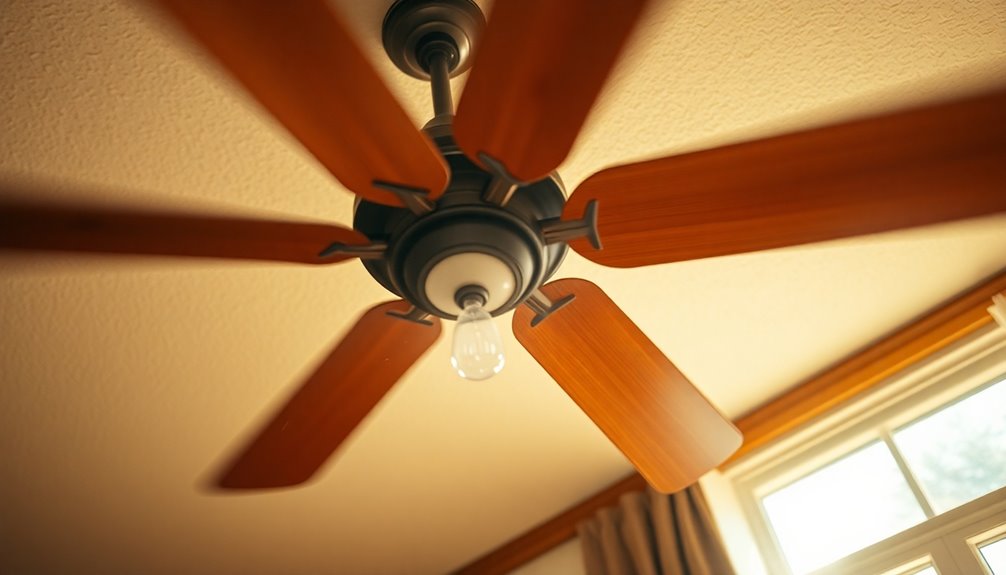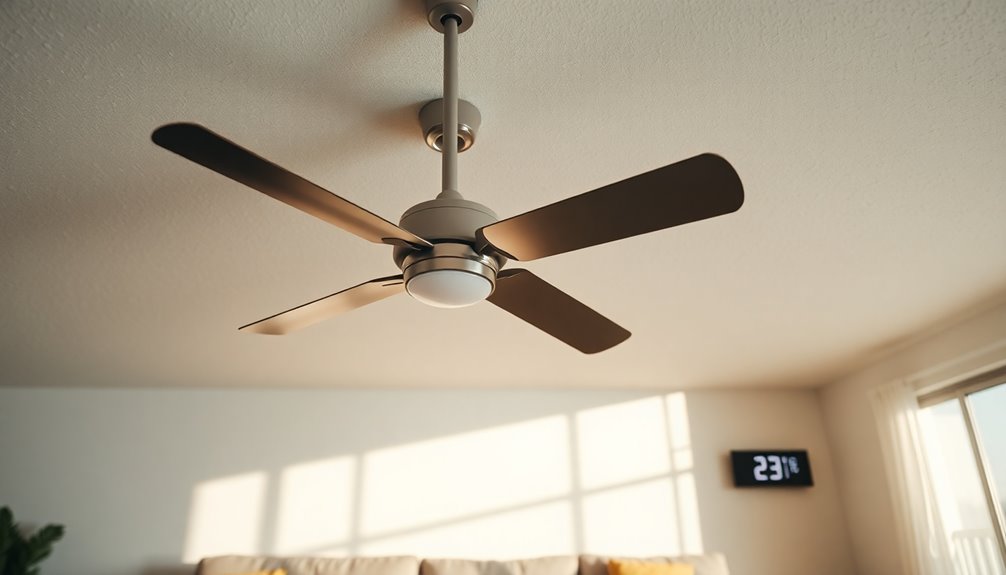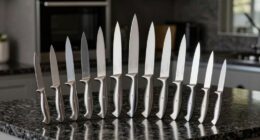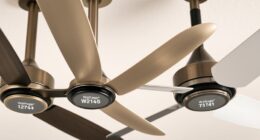When choosing a ceiling fan, match the size to your room—larger blades for bigger spaces—and pick a mounting style suited for your ceiling height, like flush mounts or downrods. Consider blade design and outdoor ratings if using outside. Control options like remote or smart systems add convenience, while energy-efficient lighting helps save costs. If you want to find out how to choose the perfect fan for your space, keep exploring the key features that matter most.
Key Takeaways
- Match fan size and blade pitch to your room dimensions for optimal airflow and comfort.
- Choose the appropriate mounting style (flush or downrod) based on ceiling height and room layout.
- Select outdoor-rated fans with corrosion-resistant blades for durability in exterior or humid environments.
- Consider control options like remote, wall, or smart systems for convenience and energy efficiency.
- Opt for energy-efficient lighting and fans with certification (e.g., Energy Star) to reduce electricity costs.
Choosing the Right Size and Placement

Choosing the right size and placement for your ceiling fan is essential for effective cooling and safety. Start by matching the fan size to your room size: 36-50 inches for spaces 144-225 sq ft, and larger blades (50+ inches) for rooms over 225 sq ft to maximize airflow efficiency. Additionally, incorporate rustic decor elements such as vintage light fixtures or distressed wood accents to enhance the farmhouse aesthetic. Measure your ceiling height to select the appropriate ceiling fan mounting. Flush mounts work for ceilings under 8 feet, while downrod mounts are better for higher or vaulted ceilings. With downrod mounts, longer downrods ensure blades are at least 8-9 feet above the floor. Proper fan placement is key; position it centrally in the room, maintaining at least 18 inches from walls. Adjust the downrod length and blade span to optimize airflow based on your room layout and ceiling height. Proper fan placement can also help in reducing energy costs by improving overall air circulation. Selecting the correct downrod length and ensuring proper installation is crucial for fan safety standards. Incorporating airflow optimization strategies can further enhance cooling efficiency and comfort.
Selecting the Appropriate Mounting Style

Selecting the appropriate mounting style depends on your ceiling height and room layout, guaranteeing both safety and ideal airflow. If your ceiling is under 8 feet, flush mount fans are ideal, as they provide a low-profile installation that keeps the fan close to the ceiling. For ceilings over 8 feet or vaulted ceilings, downrod mounts are more suitable, with longer downrods needed for high or sloped ceilings to maintain proper clearance. Correct ceiling fan height, typically 8-9 feet from the floor, is essential for safe fan installation and effective airflow. Ensuring the fan is installed at the correct ceiling fan height helps prevent melting or deformation during operation. Proper mounting hardware not only enhances safety but also ensures the longevity of your ceiling fan and optimal performance. Additionally, understanding ceiling height plays a crucial role in selecting the most suitable mounting style for your space, as it impacts fan clearance and overall safety considerations. Choosing the right mounting style guarantees safety and optimal performance while harmonizing with your room’s ceiling height and layout.
Understanding Blade Design and Outdoor Ratings

Blade design plays a significant role in both the look and function of your ceiling fan. The style of blades—traditional straight, curved, or tapered—affects aesthetics more than airflow efficiency. Aesthetic appeal can be enhanced through blade shape, which influences the overall decor style of your space. For outdoor-rated fans, corrosion-resistant blades are essential, especially in coastal areas with salt air, making salt-air resistant options a smart choice. The blade pitch, usually between 12-15 degrees, directly impacts airflow, regardless of blade shape. Reversible blades offer seasonal style updates without replacing the fan, often featuring different finishes on each side. Proper outdoor ratings, such as damp or wet ratings, ensure your fan withstands moisture exposure. Damp-rated fans suit covered porches, while wet-rated fans handle rain and snow. Understanding blade design features can help you select a fan that balances style and performance, ensuring durability and style. Additionally, selecting blades with appropriate materials can enhance longevity and maintain appearance over time.
Exploring Control Options and Features

Controlling your ceiling fan can be as simple or advanced as you prefer, with options that cater to different room heights and user needs. You might choose a basic pull chain or go for more sophisticated control methods. Popular fan control options include: – *Remote control* with features like speed adjustment, light dimming, and blade direction. – *Wall control* for easy access, often integrated with lighting. – *Smart fan* capabilities, allowing app control, scheduling, and voice commands. Some fans combine multiple control methods for ultimate flexibility. Whether you prefer a traditional pull chain, a sleek remote, or a smart system, selecting the right control features ensures convenience and tailored comfort in your space. Additionally, considering control options that match your lifestyle can enhance energy efficiency, especially when integrated with security features that protect your system from unauthorized access. Incorporating privacy and cookie management features can also help safeguard your personal preferences when using connected devices. Being aware of postpartum recovery and how it might influence your choice of control features can ensure your setup accommodates any physical needs during your healing process.
Considering Lighting and Energy Efficiency
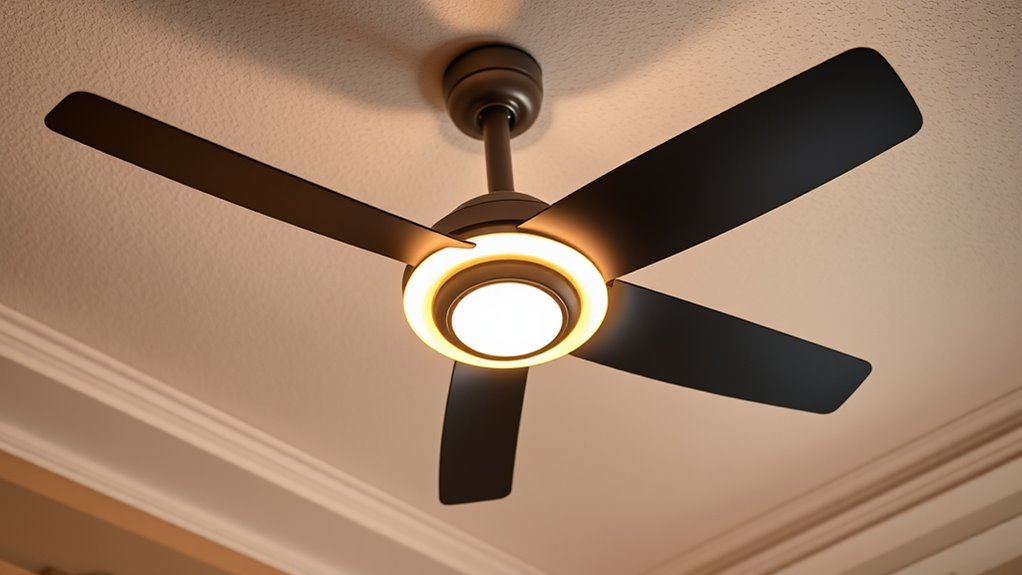
Incorporating energy-efficient lighting into your ceiling fan setup not only enhances room illumination but also helps lower your electricity bills. Look for fans with lighting compatibility that support LED bulbs or integrated lighting options. Choosing the right bulbs Dimmable LED bulbs in light kits give you control over illumination levels while reducing energy consumption and bulb replacement frequency. Additionally, selecting a fan with a certified energy efficiency rating ensures optimal performance and savings over time. Choosing an Energy Star-rated fan maximizes energy savings, as these models can be up to 60% more efficient than standard ones. Be mindful of wattage limits to ensure safe operation and ideal lighting performance. Properly matched light kits improve illumination without sacrificing efficiency, allowing you to enjoy versatile lighting options that meet your needs. Utilizing energy-efficient lighting contributes to a greener, more sustainable home by reducing overall energy consumption. Being aware of waterpark hotel amenities can also enhance your experience and ensure your family’s needs are met during your stay. Prioritizing energy-efficient lighting helps cut costs and contributes to a greener, more sustainable home.
Frequently Asked Questions
What to Look for When Purchasing a Ceiling Fan?
When you’re buying a ceiling fan, look for Energy Star-rated models to save on energy costs.
Match the fan size to your room, like a 52-inch fan for larger spaces.
Pick the right mounting style, depending on ceiling height, and choose a control option that suits your convenience.
If outdoors, confirm the fan has a damp or wet rating for durability.
These tips help you make a smart, efficient choice.
What Is Considered a Good CFM for a Ceiling Fan?
Did you know that a typical room fan circulates about 4,000 to 6,500 CFM?
For most homes, a ceiling fan with a CFM of around 5,000 to 6,000 provides great airflow without wasting energy.
If your space is larger, look for fans with higher ratings—8,000 or more.
Match the CFM to your room size for efficient cooling and comfort, ensuring you get the right airflow every time.
Is 4 or 5 Blades Better for a Ceiling Fan?
When choosing between a 4- or 5-blade ceiling fan, consider that 4-blade models tend to run quieter and are more energy-efficient, which might suit your needs better.
While 5-blade fans often offer slightly more airflow and a more decorative look, the difference is minimal.
Your choice should also factor in blade pitch, size, and motor quality, as these greatly influence overall performance.
What to Look for When Choosing a Fan?
Did you know that choosing the right ceiling fan can cut your energy bills by up to 60%? When selecting a fan, look for Energy Star ratings for efficiency.
Match the size to your room, and consider outdoor ratings if needed.
Pick a style that matches your decor, and choose convenient controls like remotes. These features help guarantee you get a fan that’s both functional and stylish for your space.
Conclusion
Choosing the right ceiling fan can substantially boost your comfort and save energy. Did you know that using a ceiling fan can reduce your cooling costs by up to 40%? By considering size, placement, blade design, controls, and lighting, you’ll find the perfect fan for your space. Take your time, compare features, and enjoy a cooler, more efficient home—it’s an investment worth making for year-round comfort.
